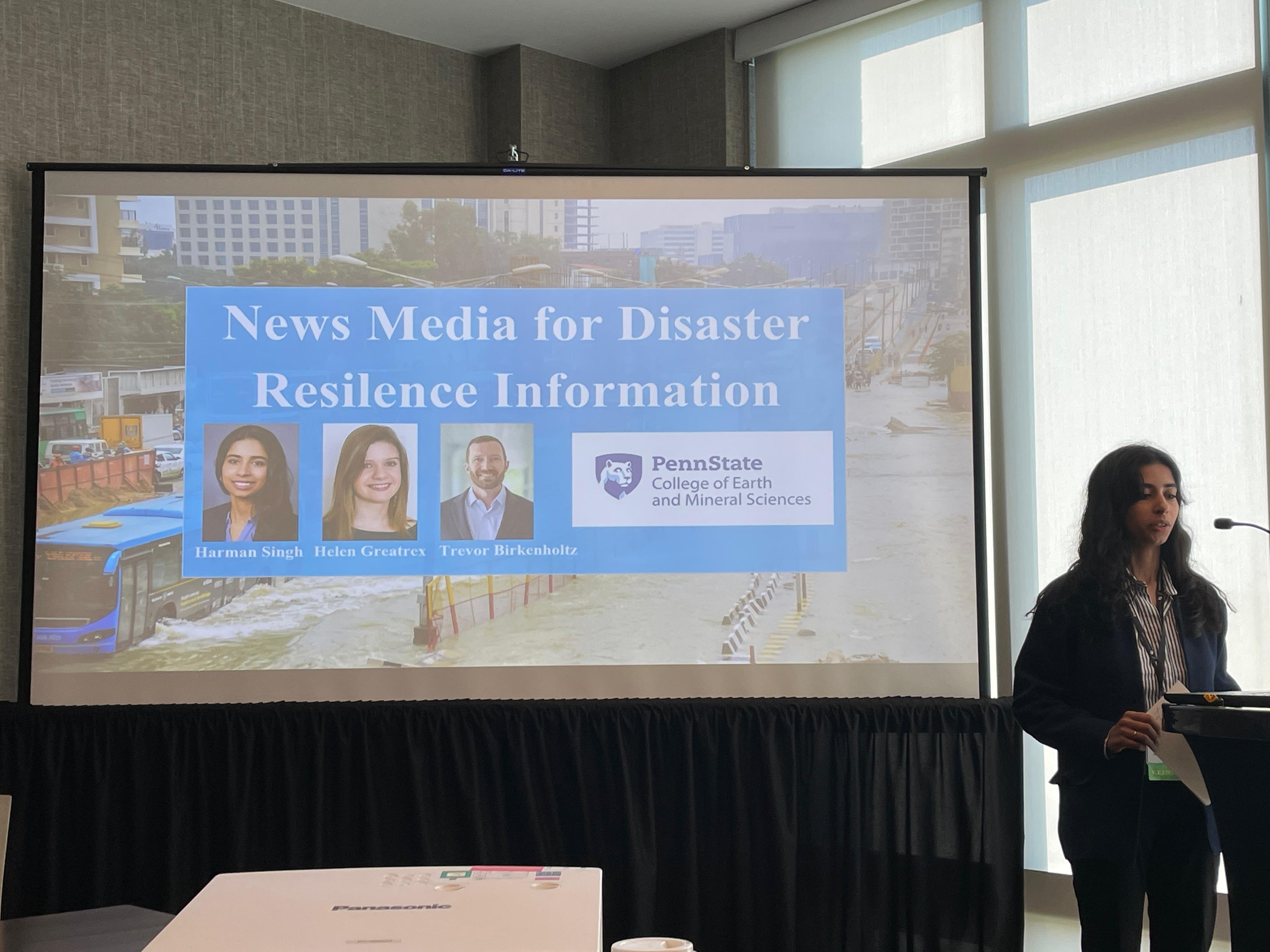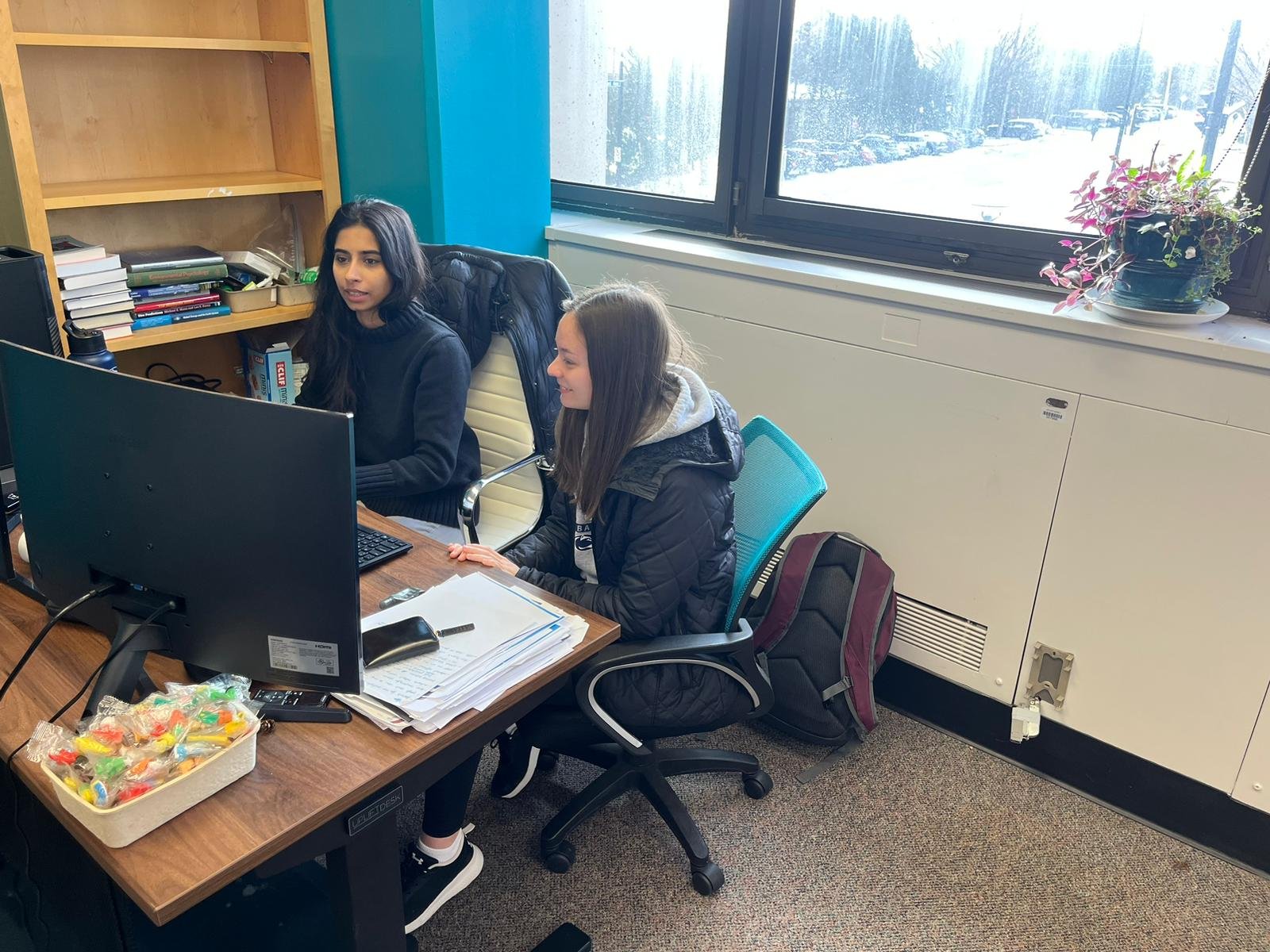NHERI Feature Series: Resiliency for All
An Interdisciplinary Approach to Inland Flooding
NHERI Grad Student Council President Harman Singh unites geography and climate science in her natural hazards research
Published on January 21, 2025
Harman Singh
PhD candidate
Penn State University
President, NHERI Graduate Student Council
My name is Harman Singh. I am an international student from India. I originally came to the U.S. to pursue an undergrad degree in geography at Penn State. I found wonderful advisors here, and I am now in a dual title PhD program, where my primary program is still geography, and my secondary program is in climate science.


Singh presents at the 2024 Researchers Meeting hosted by the Natural Hazard Center, University of Colorado Boulder, July, 2024.

Singh (left) mentors undergraduates conducting research at Penn State through the university’s Undergraduate Research Opportunities Connection (UROC) program.

In the field, Harman Singh (left) plants trees at the 2024 tree planting activity organized by the College of EMS Sustainability Council: Student Committee. Students planted over 2000 trees to reclaim formerly mined land in Phillipsburg, Pennsylvania. For the past 3 years, Singh has served as chair of the EMS Sustainability Council: Student Committee.
Q: How do you define resilience?
I think of resilience as a process that leads to recovery, happening at different scales, and led by the motivation or capacity to withstand changes brought on by a disaster.
Q: A layman might not see connections between the fields of geography, climate science, and natural hazards. Can you describe these fields and how they are interconnected?
The field of geography is very broad. In our department at Penn state, we have folks studying a wide range of topics within which natural hazards is a small niche. Geography is the study of space and time and how phenomena maybe GIS — geographical information systems — or by looking at human-environment relationships.
I use both GIS and social science methods to look at human-environment connections. I find that natural natural hazards and disasters fit in the field of geography when trying to understand human-environment interactions. The climate aspect is something I picked up later. Climate science and meteorology generally focus on a lot of modeling, but climate science also has an interdisciplinary perspective that helps me interpret model results in relation to the changing climate that is having an impact on rainfall patterns —especially since I study flooding.
Q: What drew you to these fields of study?
My undergrad and master’s research focused on flooding in India, and my PhD dissertation specifically centers on flooding in Benaluru, India. More recently, I've been interested in inland flooding, flooding that happens in the absence of a river or waterbody. In India, and globally, we are seeing an increase in inland flooding because of rapid urbanization happening in cities and the difficulties that emerge in maintaining and investing is new drainage to keep up with urban growth.
I am very interested in the monsoon. I grew up in India, in a city, which is where my interest in urban environments come from. As I was growing up, I saw the monsoon changing — especially when it would start, when it would end. The monsoon in India lasts an entire season and impacts agriculture, transportation, and daily activities. For example, schools would be closed more frequently due to rain, or we would see waterlogging in our street. And water was slowly creeping up to the level of our house. So people would have to replace their furniture every year, and that became a problem. These changes made me think about folks who live in more low-lying areas, oftentimes marginalized communities, who would face a difficult time with daily transportation.
So that's really what sparked my interest. Why I'm in this field. I want to know: What can we do for urban environments where flooding may not seem like a big deal now, but is increasingly becoming a big deal each year?
in India, traditionally rainfall is welcomed, specifically for agricultural reasons. There are several rainfall- related festivals in many Indian cultures. But now, rainfall and the monsoon, especially later in the season, are not viewed from a welcoming lens because of recent extreme flood events. I remember, as a kid, making paper boats floating them down the street, and you'd watch them flow with the water. It was a fun activity, but now one sees less of due to safety concerns of letting children outside when there is intense rainfall.
Q: Can you tell us your plans for future studies?
In the future I am interested in looking at inland flooding in the U.S. For example, in Pennsylvania, you get a lot of inland flooding. Just this past summer, the street behind our building at Penn State was flooded. And in the eight years I’ve been here, I've never seen it flood like that.
So, in general, I'm interested in looking at policy changes around inland flooding, in India and the U.S., and if there are any parallels in the future between adaptation planning. I am interested in understanding how adaptation planning is taking place at the international level — and also the motivation and credibility behind local level adaption plans.
Q: You currently serve as president of the NHERI Graduate Student Council, which has about 600 members. And you’ve been a member of the since the GSC’s inception. Can you tell us about your involvement with the GSC?
I came across this group when Robin Nelson, our NHERI advisor, first sent an email floating the idea of forming graduate student a group. At the time I was a first-year master's student. And the idea of a Graduate Student Council really excited me, because, like I mentioned, in the Geography Department at Penn State, everybody's studying a large range of topics. So I felt a little isolated as a grad student. I didn't have peers I could talk to, for example, about specific scholarship in the field of disasters.
It was very exciting for me — being so far away, at a different university — to still be able to connect with other grad students who are studying something similar. In the GSC meetings I could talk with people about research challenges or gaps, and even just generally, about being a grad student in the field of disaster research. And since NHERI GSC members come from so many different fields, I was able to learn more about other disciplines that study disasters and how we could all move toward achieving interdisciplinary research. All of these things really motivated me to join the NHERI GSC and stay active.
My interest in DEI stemmed from me being an international student, always trying to understand how I belonged in any space — and trying to see how I could make other students feel more comfortable in any space. I was part of the first Grad Student Council DEI leadership group and helped establish its goals. We created a statement of inclusivity that everybody must sign. We hold workshops on diversity and inclusion. I also help with the NHERI Research Experiences for Undergraduates program by hosting a DEI workshop since 2022. Eventually, time came to decide if I wanted take on another role in the GSC. So I ran for a few of officers positions, and was elected president.
Q: What are your goals as GSC President?
I would like to see more inter-committee collaboration. The GSC has a number of standing committees. Each of them do something different, and yet I feel like a lot of us have overlapping goals. I'm hoping to connect committees to achieve common goals.
Also, in the two or three months that I have stepped up as president, we're also trying to form more connections with alumni. The NHERI GSC has been around since 2021, and we're now entering that phase where members have graduated, and they're GSC alumni. So how do we keep them in network so that they could mentor current GSC folks? Or even connect members in the job market since alums now know more about the job market. We're trying to foster all of those connections and bring alumni back to serve as panelists during workshops. We’d start like to start an alumni chapter of the GSC, if we can.
Q: You’ve had so many rich experiences in academia. Do you have advice for undergraduates, or even high school students?
I was a very, very shy student. I was the student who would not ask questions in class. I maybe would not go to a professor's office hours. I was that shy. I was also very shy about my English not being good. That's where my DEI understanding comes from. So, I really want to uplift students who feel like they don't belong in this foreign setting – but they do. To undergraduates, I would say: take your time. Everybody's time is different. I used to compare myself to my peers in high school who were very confident, but I became more confident when I became a grad student.
So, my advice would be, take your time, don’t rush into things. And try to do something that makes you slightly uncomfortable. I think that's where we can really start to grow.
When we are slightly uncomfortable, slightly stressed — I feel like that's where growth happens. Not extremely stressed! But take it bit by bit and grow from there. For example, every year in grad school, I tell myself I'm not going to do more than I did last year. That was a lot! But my capacity builds every year, because I make myself just a little bit uncomfortable to try something new.
At Penn State we have a formal program to mentor undergrads for research. I am mentoring four undergrads this semester. A lot of them just want to talk to me about grad school, want to know what it’s like. Others ask practical things like, ‘How do you make a research poster?’ Together, we just focus on whatever they want to learn about. I think my flexibility gives them a kind of independence as well as confidence. Along with the research plan that I have set for the semester they can ask for help on learning a new skill or advice.
Q: Where do you see yourself in five years?
That's a tough question. I would like to be an academic, if it works out. There are a lot of moving parts to that when you're on the job market. Nevertheless, I would like to be a tenure-line professor if I could at an R1 university. Or at a natural disaster hazard or disaster lab like the University of Colorado, Boulder, or the University of Delaware. I am especially interested in identifying as an interdisciplinary researcher. I want to sit somewhere in the middle where I could have the capacity to fluidly navigate between a variety of research methods, collaborations, and disciplinary perspectives.
Resilience for All
In this Q&A series, we profile NHERI researchers working to improve resilience in underserved populations.
Related Links
Harman Singh recognized as John Roe Sustainability Impact Awardee | Penn State University
Penn State Undergraduate Research Opportunities Connection (UROC) program
Penn State College of EMS Sustainability Council Student Committee





